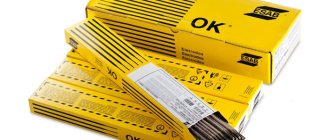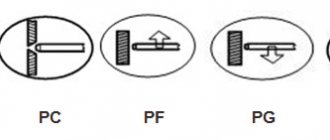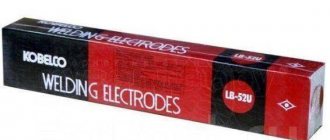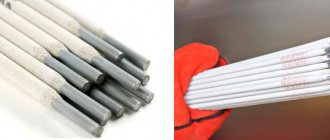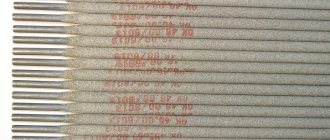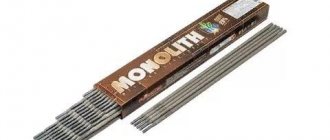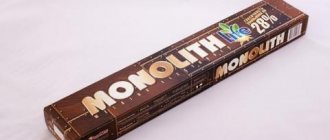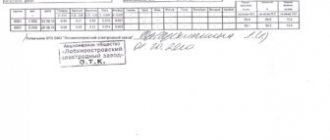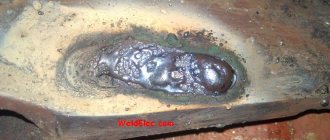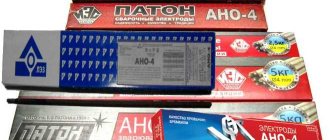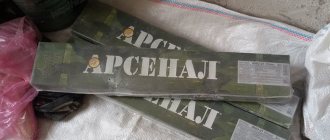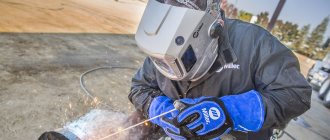Purpose and GOST
Products are produced for connecting steel parts:
- installation of pipes and gas pipelines in the absence of pressure;
- assembling structures using fillet welds.
ANO-21 is used in shipbuilding, housing and communal services, repair shops, dachas and private homes. Rods with a diameter of 2.5 and 3 mm are often used.
Products are manufactured in compliance with GOST 9467-75 and coated on the outside with a rutile coating. It stabilizes the arc, reduces the rate of spattering of hot metal, prevents the occurrence of oxidation processes, and protects the seam from oxygen penetration.
At the junction of the parts, a smooth roller is formed that does not contain pores. Approximately 1.5 kg of rods are consumed per hour. This is a high figure.
ANO-21 welding electrodes are used when connecting steel products and parts made of other metals. The rods are easily excited and maintain an arc, are powered by a 220 V electrical network, and form an easily removable slag coating. This corresponds to GOST 380-2005 or 1050-88.
Welding is carried out with direct and reverse current. ANO-21 guarantee the quality of work.
Technical characteristics of ANO-21
The technical parameters of the product provide for the ability to operate with arbitrary polarity of alternating current. With proper storage and preparation of electrodes, as a rule, problems with arc ignition do not arise during the welding process.
The weld is formed due to small scaly beads, which is the best option for workpieces of small thickness, since thermal deformations of the metal do not occur.
ANO-21 electrodes with ordinary coating and without additional protection should not be used for welding aluminum structures and high-carbon steel grades, since such operations require special products containing additional additives that compensate for the high carbon content.
Advantages and disadvantages of ANO-21
Like most other brands of consumables for welding work, ANO-21 electrodes have both advantages and disadvantages.
Among the advantages we note the following:
- market availability and wide popularity;
- low cost;
- easy arc ignition regardless of working conditions;
- formation of a smooth layer of slag, easily separated from the deposit during testing;
- the formation of a sealed seam from fine-scaled deposits.
Let's not ignore the disadvantages:
- narrow scope of application;
- insufficiently reliable coating, which requires the use of additional fluxes and preparation of workpieces;
- insufficient strength of the seam, which cannot withstand serious impacts and pressure;
- poor-quality seam when working with workpieces of considerable thickness.
Explanation of markings
The symbols that are part of the full name of the product - E46-ANO-21-d-UD E 430/3/- R 11, have the following meanings:
- E46 – product type;
- ANO – brand;
- D – diameter;
- U – intended for carbon steels;
- D – thick protective coating;
- 43 – level of seam rupture;
- 0 – elongation 18%;
- 3 – viscosity;
- R – rutile coating;
- 1 – welding position – any;
- 1 – alternating current.
The rods were developed by scientists from the Electric Welding Institute.
Letter designations:
- A – Academy;
- N – Sciences;
- O – coated;
- 21 – model.
The data will help beginners choose electrode products.
An example of decoding electrode symbols.
Welding characteristics
Features of electrodes:
- product diameter – 1-5 mm;
- coating – rutile;
- metal spattering – does not exceed 4%;
- hourly consumption – 1.65 kg.
The arc remains smooth throughout the welding process.
The seam material can withstand:
- tensile strength – not less than 460 MPa;
- elongation – 18%;
- viscosity – 80 J/cm²;
- connection bend angle – 150°.
We recommend reading Composition of electrode coating
Other parameters are also important.
Chemical composition of the seam
Even for a person without work experience, the connection point between the parts is strong. Molten and solidified metal contains the elements presented in the table.
| Name | Quantity in % |
| Carbon (C) | 0,1 |
| Silicon (Si) | 0,3 |
| Magnesium (Mn) | 0,5-0,8 |
| Sulfur (S) | 0,04 |
| Phosphorus (P) | 0,045 |
The above list complies with state standards and must be observed in the production of electrodes at all factories. In practice, the composition of the seam is slightly different when welding with rods from different manufacturers.
Smooth weld seam.
Physical properties
Rutile coating consists of titanium dioxide and other substances: silica, calcium carbonate, ferromanganese. The mixture allows you to cook wet and corroded parts. You can make connections at non-rotating joints, which are often found on pipelines.
Products with a diameter of 2, 3, 4 and 2.5 mm are easy to ignite and burn evenly, the molten material hardly splashes.
The Sv-08 wire (the electrodes are made from) contains additives that can increase the surface tension in the weld pool. This allows vertical and ceiling seams to be made without leaking metal.
The maximum permissible moisture content in the coating is 0.9%. For larger values, the rods are calcined for 30-40 minutes. The temperature is 120°C. In the future, electrodes are used for welding non-ferrous and ferrous metals, incl. and aluminum.
When purchasing, you should choose dry products. You shouldn’t settle for cheap products; it’s better to buy more expensive products from popular manufacturers.
When welding with an ANO-21 electrode, there is almost no spatter.
Welding modes
These indicators depend on the thickness of the electrode. The parameters are indicated in the table indicating the spatial location of the seam.
| Diameter (mm) | Length(cm) | Quantity (1 kg) | Current (A) | ||
| Lower | Vertical | Ceiling | |||
| 2 | 30 | 95 | 60-100 | 70-80 | 80-100 |
| 2,5 | 30 | 58 | 70-120 | 70-100 | 90-110 |
| 3 | 35 | 40 | 100-150 | 90-110 | 110-140 |
| 4 | – | – | 160-190 | 150-170 | 150-180 |
| 5 | – | – | 170-220 | 150-190 | 120-160 |
It is not recommended to weld workpieces thicker than 5 mm and pipe joints with subsequent injection of pressure.
Features of the welding process
Welding is carried out using AC or DC power sources, and in the latter case the polarity does not matter.
AC devices must operate at an idle voltage of 50 V with a deviation of no more than 10% in one direction or another. A special feature of preparing the edges of products for welding is that they do not have to be cleaned to a metallic shine. Welding can be carried out not only with a short arc, but also with a long one. The dimensions of consumables and welding modes are indicated in the table:
| Thickness of welded metal, mm | Recommended electrode Ø, mm | Electrode length, mm | Welding current (A) when welding in position | ||
| 0,5 | 1,6 | 250 | lower | vertical | ceiling |
| 50 ÷ 75 | 50 ÷ 70 | ||||
| 1,0 | 1,6÷2,0 | 50÷90 | 50 ÷ 90 | ||
| 2,0 | 2,5÷3,0 | 300 | 50÷140 | 80÷130 | 70÷120 |
| 3,0 | 3,0÷4,0 | 300; 350 | 90÷200 | 100÷180 | 90÷180 |
| 4,0 | 5,0 | 400 | 160÷240 | 140÷220 | 130÷220 |
How to weld is shown in the video:
.
The moisture content in the electrode before use should not exceed 0.9%, therefore, during long-term and improper storage, it is recommended to calcinate them at a temperature of 120 °C for at least 40 minutes.
User reviews of ANO-21 electrodes speak in favor of such consumables, provided that they are not counterfeit. Therefore, carefully read who the manufacturer is and buy products that have a quality certificate. Welders write about the ease of arc ignition, the reliable connection of products made from simple steels, and note the reasonable cost.
Dimensions and packaging
After release, the finished products are placed in moisture-proof film and a cardboard box. Packages of 1 or 5 kg are available for sale.
| Rod Diameter (mm) | Length(cm) | Weight 1 pc. (G) | Quantity per 1 kg |
| 1,6 | 25 | – | – |
| 2,0 | 25 | – | – |
| 2,5 | 30 | 17,0 | 58-59 |
| 3,0 | 30 or 35 | 26,5 | 38 |
| 4,0 | 45 | 53,0 | 18-19 |
| 5,0 | 45 | 84,5 | 12 |
| 6,0 | 45 | 135,0 | 7 |
We recommend reading Characteristics of OZS-12 electrodes
Small packages are convenient for home use.
Consumption rate
When connecting parts in small volumes, a competent calculation of the required number of electrodes and the diameter of the rod will ensure the continuous activity of the master and eliminate unjustified monetary costs.
This requires parameters that are inserted into tables developed by scientists from the Montazhspetsstroy Research Institute and other organizations. Detailed information about the types of welding is presented in document VSN 452-84.
In practice, the consumption is 1.65 kg for every hour of operation.
Areas of application
As follows from the above advantages and disadvantages, this brand is intended mainly for performing the simplest welding operations, such as assembling structures from light metal profiles. In addition, this material can be used for welding thin-walled pipelines operating under low pressure . ANO-21 are not intended for welding critical components and structures subject to increased loads.
Electrodes of this brand are often used in everyday life to create metal structures, the strength characteristics of which are not critical.
Chemical composition of ANO-21
Regardless of the length and diameter of the rod, all electrodes of this brand have the following chemical composition:
- Carbon 0.1
- Silicon 0.3
- Manganese from 0.5 to 0.8
- Sulfur 0.04
- Phosphorus 0.045
Pros and cons of using
Positive aspects of the rods:
- accessibility for all users;
- fast ignition and stable arc burning;
- hot metal hardly splashes;
- formation of an easily removable slag layer;
- seam strength;
- lack of sensitivity to galvanic protection and traces of rust on the edges of the metal being welded;
- reduced toxicity.
Negative features:
- welds only metals up to 5 mm thick;
- the use of fluxes is required;
- impossibility of welding high pressure pipelines.
Prices cover all existing shortcomings. You can purchase materials of different diameters in specialized stores by paying 70-152 rubles per 1 kg.
A pack of electrodes weighing 5 kg.
Features of working with ANO-21
It should be taken into account that to melt products with a rod with a diameter of 2.5-3 mm, an increase in welding current is required. To avoid thermal deformation of the workpiece, and at the same time, to prevent regular sticking of the electrode due to low current, it is recommended to observe the following welding modes:
Rod Diameter Recommended Amperage
2 mm 50 - 90 A
3 mm 60 - 110 A
3.5 mm 90 – 140 A
Features of operation and storage
The main property of rods coated with rutile coating is that they work in conditions of high humidity of the parts being welded and with metals with traces of rust on the edges being joined.
The electrode must remain dry. Therefore, it is better to store it in a hermetically sealed box in a warm room, away from the ground, away from sunlight. If it gets wet, it is dried for 40-60 minutes at a temperature of +90 ... +120 ° C.
Vertical fillet welds are made by holding the electrode at an angle of 40-70°. Do not exceed the recommended currents, this will lead to metal burns. The seam always turns out strong even by welders without experience. Waste is easily removed from metal.
Rods should be purchased from specialized stores that comply with the rules for storing welding consumables. The temperature in the warehouse must be at least +15°C.
Comparison table
Electrode products, including ANO-21, are produced by several enterprises. The manufacturing technology is not followed at all, for this reason the properties of products from different manufacturers differ in ignition, maintaining arc stability and the appearance of pores.
We recommend reading How graphite electrodes are used
Masters conducted comparison tests with the participation of ANO-21, MR-3 and SSSI. The test results depending on the welding direction are shown in the table.
| Index | ANO-21 | MR-3 | SSSI |
| Metal consumption (1 kg) | 1,7 | 1,7 | 1,6 |
| Viscosity (J/cm²) | 80 | 80 | 200 |
| Elongation (%) | 18 | 18 | 26 |
| Capacity (kg/h) | 1,4 | 1,7 | 1,3 |
| Yield Strength (MPa) | 460 | 400 | 350 |
| Maximum current (A) | 220 | 260 | 200 |
| Minimum current (A) | 40 | 30 | 40 |
| Calcination (min.) | 60 | 60 | 60 |
The table will help in selecting the electrodes needed for the job.
The best manufacturers
The rods are manufactured at various enterprises in Russia and abroad.
Popular companies producing rods:
- Lincoln Electric (USA);
- ZELZ (Zelenograd);
- LEZ (Moscow);
- "Paton" (Kyiv);
- "PlasmaTek" (Ukraine);
- "Strength" (Kyiv);
- "SpetsElectrod" (Volgodonsk);
- "TANTAL LTD" (Syzran);
- "Sumy-Electrode" (Ukraine);
- YaEMP (Yaroslavl).
Analogues of products are considered to be:
- ESAB OK 46.00;
- BÖHLER FOX SPE;
- ANO-4;
- OZS-6;
- MP-3;
- RC standard;
- OZS-12.
Top businesses:
- "Paton";
- "Granite";
- LEZ;
- KOMZ;
- MaxWeld;
- "Tigarbo";
- "Monolith".
